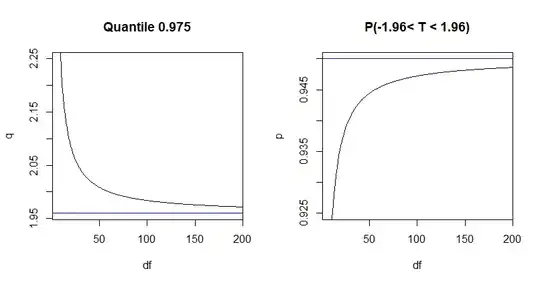As degrees of freedom $\nu$ increase, the tails of Student's t distribution contain
less probability, with the normal distribution being the limiting case.
As $\nu = n-1$ increases, quantile 0.975 $q$ decrease to the normal value 1.96. For example, a t confidence interval $\bar X \pm qS/\sqrt{n}$ gets closer to
the z confidence interval $\bar X \pm 1.96 \sigma/\sqrt{},$ for known population standard deviation $\sigma.$
For the standard normal distribution, the probability $p = P(-1.96 < Z < 1.96) = 0.95.$
As $\nu$ increases, $p = P(-1.96, < T < 1.96)$ increases to the normal value.
Many elementary textbooks say that, for $\nu = 30,$ the t distribution is sufficiently close
to normal for some practical purposes. But $\mathsf{T}(\nu=30)$ is hardly the same
as $\mathsf{Norm}(0,1).$
Here are graphs of $q$ and $p$ for $\nu = 1, 2, \dots, 200.$ The R code used to make the plots is shown below.

df = 1:200
q = qt(.975, df)
pu = pt(1.96, df); pl = pt(-1.96, df); p = pu-pl
par(mfrow=c(1,2))
plot(df,q, type="l", ylim=c(1.96,2.25), xaxs="i", main="Quantile 0.975")
abline(h = 1.96, col="blue")
plot(df,p, type="l", ylim=c(.925,.95), xaxs="i", main="P(-1.96< T < 1.96)")
abline(h = diff(pnorm(c(-1.96,1.96))), col="blue")
par(mfrow=c(1,1))
